- Abstract
- Harvest yield of Shishito peppers (main data).
- Harvest volume of Shishito peppers among bell peppers (by prefecture).
- Area planted for Shishito peppers (main data).
- The area cultivated for Shishito peppers among bell peppers (by prefecture).
- The shipping volume of Shishito peppers among bell peppers.
- Reference
Abstract
In Japanese agriculture, Shishito peppers are one of the most important fruit vegetable crops. It has been confirmed that the national harvest volume for 2022 was 5.96kt, with a cultivated area of 293ha, and Kochi had the highest shipping volume of 2.01kt. These figures show that shishito pepper production is concentrated in a relatively limited area, with Kochi being one of its centers. In addition, a comparison of production and shipping volumes indicates that the majority of the shishito peppers produced are supplied to the market. This trend suggests that there is a relatively good balance between supply and demand. Furthermore, due to the relatively small area required, shishito pepper production is efficient and potentially profitable for farmers. In general, shishito pepper production is concentrated in certain regions, and it can be said that there is a supply system in place to meet demand.
Harvest yield of Shishito peppers (main data).
In Japanese agriculture, shishito pepper harvest volumes have fluctuated between 1989 and 2022. At its peak in 1990, traffic nationwide reached 13 kt, but has been steadily declining since then, currently standing at 45.8% of its peak level. This trend is likely due to changes in agricultural structure and market demand. The modernization of agriculture and urbanization are resulting in a decrease in farmland and an aging farming population, which is leading to declining harvests. Other factors that may be contributing include changes in consumer tastes and competition from foreign products. Given this background, the shishito pepper harvest volume has decreased compared to its peak, but efforts are needed to adjust production and improve quality in response to changes in demand and market conditions.
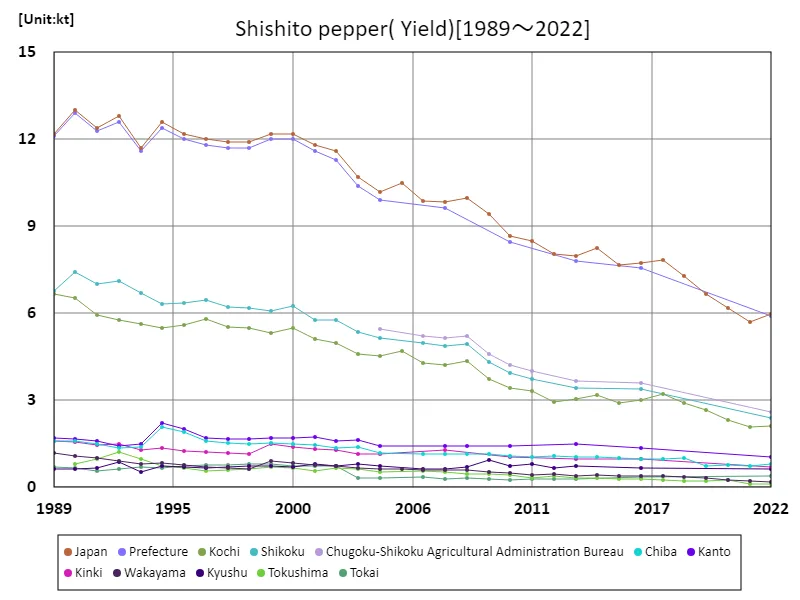

The maximum is 13kt[1990] of Japan, and the current value is about 45.8%
Harvest volume of Shishito peppers among bell peppers (by prefecture).
In Japanese agriculture, fruit vegetable harvest yields will be analyzed based on the latest data from 2022. According to prefecture-by-prefecture data, Kochi recorded the highest yield that year, achieving 2.12kt, the highest overall. This is a departure from past trends and marks Kochi’s highest ever yield. This characteristic is thought to be due to regional agricultural policies, technological innovations, and the influence of climatic conditions. Additionally, since Kochi has significantly higher yields than other prefectures, it is possible that the characteristics and production environment of each region are suitable for cultivating fruit vegetables. This indicates regional disparities in agricultural production and differences in competitiveness. In general, fruit vegetable yields vary by region, with regional agricultural policies and environmental factors influencing production volumes.
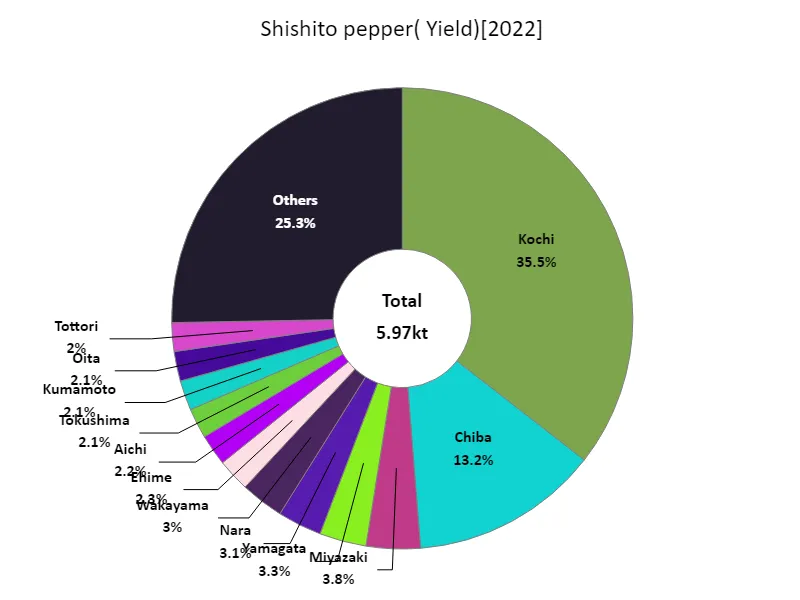

The maximum is 2.12kt of Kochi, the average is 127t, and the total is 5.97kt
Area planted for Shishito peppers (main data).
In Japanese agriculture, the area cultivated with shishito peppers has fluctuated from 1989 to 2022. At its peak in 1994, the entire country recorded 445 hectares, but it has since declined and is currently at 65.8% of its peak. This trend is likely due to changes in agricultural structure and market demand. The area under cultivation may be declining due to urbanization of farmland and more advanced agricultural practices. Another factor is the adjustment of crop cultivation in response to changes in demand and new demand trends. Given this background, the area of land planted to shishito peppers has decreased compared to its peak, but this may be due to production adjustments and efficiency improvements in response to changes in demand and market conditions. It is becoming increasingly important to cultivate crops that take into account farm management efficiency and sustainability.
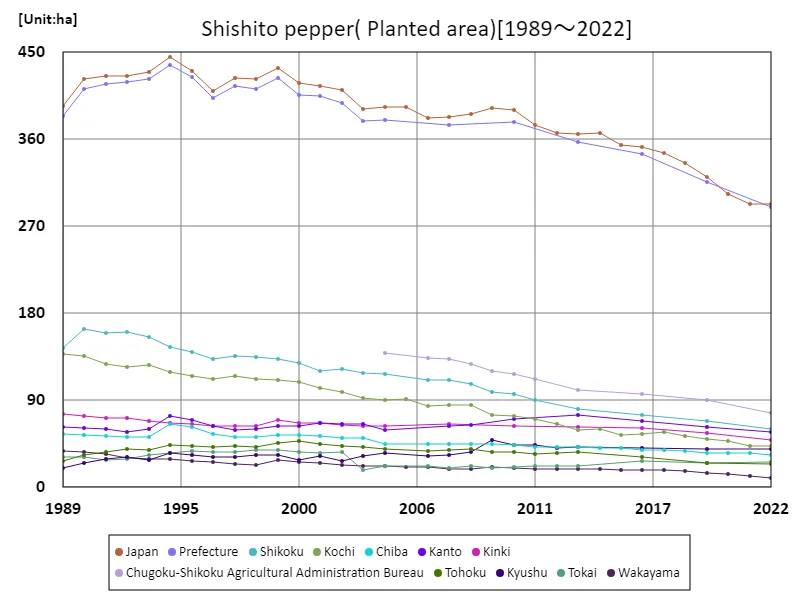

The maximum is 445ha[1994] of Japan, and the current value is about 65.8%
The area cultivated for Shishito peppers among bell peppers (by prefecture).
We will examine the area of land used to cultivate fruit vegetables in Japanese agriculture based on the latest data from 2022. According to prefecture-wise data, Kochi recorded the highest cultivated area that year, achieving the highest overall area of 43 hectares. This is a departure from past trends and marks Kochi achieving higher acreage than ever before. This characteristic is thought to be due to changes in regional agricultural policies, production environments, technological innovations, etc. In addition, since Kochi has a significantly higher cultivated area than other prefectures, it is possible that the region’s agricultural characteristics and climatic conditions are suitable for cultivating fruit vegetables. Given this background, the area of land used to cultivate fruit vegetables varies by region, with local agricultural policies and environments influencing production volume. When considering the sustainability of agriculture and its contribution to local economies, it is important to implement production adjustments and support measures that take into account the characteristics of each region.
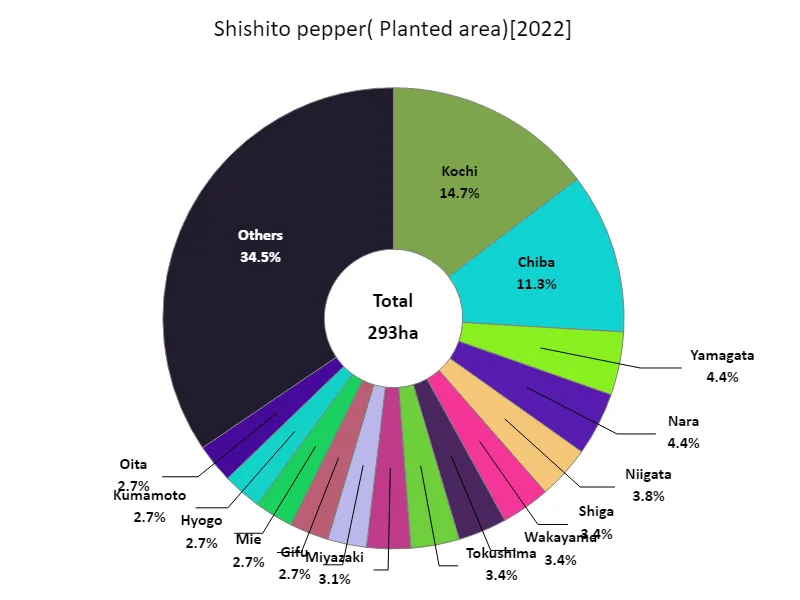

The maximum is 43ha of Kochi, the average is 6.23ha, and the total is 293ha
The shipping volume of Shishito peppers among bell peppers.
We will examine the shipping volume of Shishito peppers in Japanese agriculture based on the latest data from 2022. The highest overall shipment for the year was from Kochi, which reached 2.01kt. The average shipment was 105t and the total shipment was 4.91kt. These figures indicate that shishito pepper shipments are sourced from a relatively diverse range of regions, with Kochi being one of the centers. Additionally, the relatively low average shipment volume suggests that shishito pepper production varies across regions. In order to maintain a balance between supply and demand, it is important to adjust production between regions and streamline logistics. Furthermore, with total shipping volumes representing less than half of the total harvest, it is possible that some shishito peppers are being diverted for processing or other uses outside the consumer market. Given this background, it is suggested that shipping volumes of Shishito peppers fluctuate depending on the region and use, and that adjustments between supply and demand are necessary. When considering the sustainability of agricultural production and its contribution to the local economy, it is necessary to develop effective production management and market strategies.
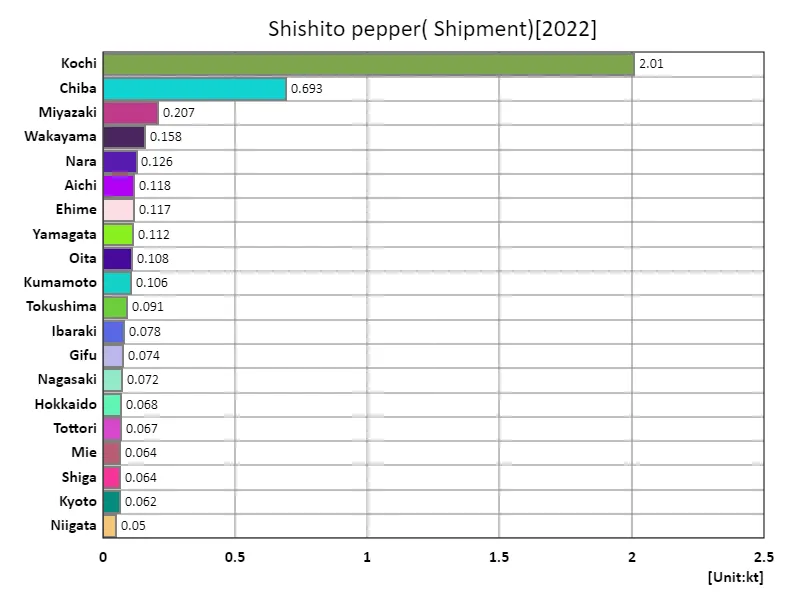

The maximum is 2.01kt of Kochi, the average is 105t, and the total is 4.91kt
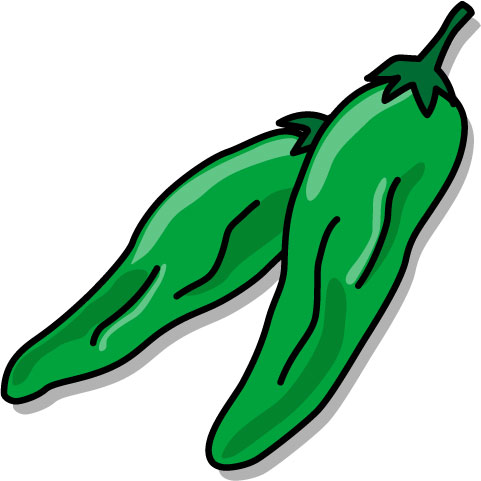


Comments